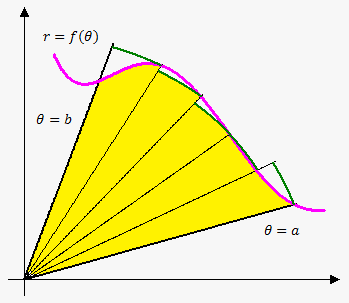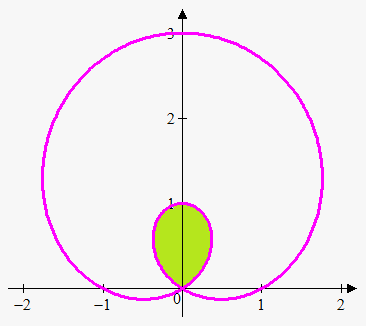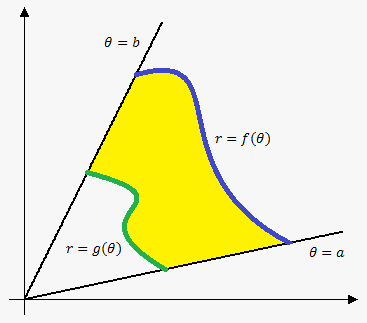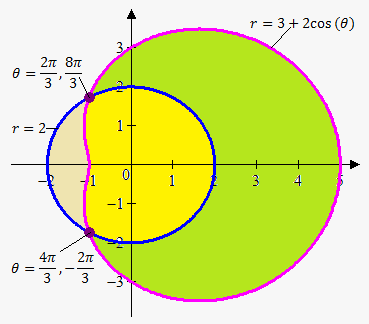Area in Polar Coordinates
To find area in polar coordinates of curve on interval $$${\left[{a},{b}\right]}$$$ we use same idea as in calculating area in rectangular coordinates.
So, consider region, that is bounded by $$$\theta={a}$$$, $$$\theta={b}$$$ and curve $$${r}={f{{\left(\theta\right)}}}$$$.
We divide this region into $$${n}$$$ subintervals of length $$$\Delta\theta=\frac{{{b}-{a}}}{{n}}$$$.
Now choose in each interval $$${\left[\theta_{{{i}-{1}}},\theta\right]}$$$ sample point $$${\theta_{{i}}^{\star}}$$$ (on the figure we chose right endpoint) and approximate area on i-th subinterval by area of sector whose radius is $$${r}{\left({\theta_{{i}}^{\star}}\right)}$$$: $$${A}_{{i}}=\frac{{\Delta\theta}}{{{2}\pi}}\cdot\pi{{\left({r}{\left({\theta_{{i}}^{\star}}\right)}\right)}}^{{2}}$$$.
Summing these area we will obtain that required area is $$${A}\approx{\sum_{{{i}={1}}}^{{n}}}\frac{{1}}{{2}}{{\left({r}{\left({\theta_{{i}}^{\star}}\right)}\right)}}^{{2}}\Delta\theta$$$.
If we let $$${n}\to\infty$$$ then we obtain exact area $$${A}=\lim_{{{n}\to\infty}}{\sum_{{{i}={1}}}^{{n}}}\frac{{1}}{{2}}{{\left({r}{\left({\theta_{{i}}^{\star}}\right)}\right)}}^{{2}}\Delta\theta$$$.
We recognize in this sum Riemann sum, so $$${A}$$$ can be found using integral.
Area in Polar Coordinates. $$${A}=\frac{{1}}{{2}}{\int_{{a}}^{{b}}}{{\left({r}{\left(\theta\right)}\right)}}^{{2}}{d}\theta$$$.
Example 1. Determine area of the inner loop of the $$${r}={1}+{2}{\sin{{\left(\theta\right)}}}$$$.
 To handle this problem we need bound for inner loop. Loop starts at the origin and ends at the origin, so we need points where $$${1}+{2}{\sin{{\left(\theta\right)}}}={0}$$$. Solving this equation on interval $$${\left[{0},{2}\pi\right]}$$$ we obtain that $$$\theta=\frac{{{7}\pi}}{{6}}$$$ and $$$\theta=\frac{{{11}\pi}}{{6}}$$$.
To handle this problem we need bound for inner loop. Loop starts at the origin and ends at the origin, so we need points where $$${1}+{2}{\sin{{\left(\theta\right)}}}={0}$$$. Solving this equation on interval $$${\left[{0},{2}\pi\right]}$$$ we obtain that $$$\theta=\frac{{{7}\pi}}{{6}}$$$ and $$$\theta=\frac{{{11}\pi}}{{6}}$$$.
So, $$${A}=\frac{{1}}{{2}}{\int_{{\frac{{{7}\pi}}{{6}}}}^{{\frac{{{11}\pi}}{{6}}}}}{{\left({1}+{2}{\sin{{\left(\theta\right)}}}\right)}}^{{2}}{d}\theta=$$$
$$$=\frac{{1}}{{2}}{\int_{{\frac{{{7}\pi}}{{6}}}}^{{\frac{{{11}\pi}}{{6}}}}}{\left({1}+{4}{\sin{{\left(\theta\right)}}}+{4}{{\sin}}^{{2}}{\left(\theta\right)}\right)}{d}\theta=$$$
$$$=\frac{{1}}{{2}}{\int_{{\frac{{{7}\pi}}{{6}}}}^{{\frac{{{11}\pi}}{{6}}}}}{\left({1}+{4}{\sin{{\left(\theta\right)}}}+{2}{\left({1}-{\cos{{\left({2}\theta\right)}}}\right)}\right)}{d}\theta=\frac{{1}}{{2}}{\left({3}\theta-{4}{\cos{{\left(\theta\right)}}}-{\sin{{\left({2}\theta\right)}}}\right)}{{\mid}_{{\frac{{{7}\pi}}{{6}}}}^{{\frac{{{11}\pi}}{{6}}}}}=\pi-\frac{{{3}\sqrt{{{3}}}}}{{2}}$$$.
 Similarly we can derive formula for area enclosed by two curves. Indeed, if area enclosed by curve $$${r}={f{{\left(\theta\right)}}}$$$ is $$$\frac{{1}}{{2}}{\int_{{a}}^{{b}}}{{\left({f{{\left(\theta\right)}}}\right)}}^{{2}}{d}\theta$$$, area enclosed by curve $$${r}={g{{\left(\theta\right)}}}$$$ is $$$\frac{{1}}{{2}}{\int_{{a}}^{{b}}}{{\left({g{{\left(\theta\right)}}}\right)}}^{{2}}{d}\theta$$$ and $$${f{{\left(\theta\right)}}}\ge{g{{\left(\theta\right)}}}$$$ for $$${a}\le\theta\le{b}$$$ then area between them is difference of corresponding areas.
Similarly we can derive formula for area enclosed by two curves. Indeed, if area enclosed by curve $$${r}={f{{\left(\theta\right)}}}$$$ is $$$\frac{{1}}{{2}}{\int_{{a}}^{{b}}}{{\left({f{{\left(\theta\right)}}}\right)}}^{{2}}{d}\theta$$$, area enclosed by curve $$${r}={g{{\left(\theta\right)}}}$$$ is $$$\frac{{1}}{{2}}{\int_{{a}}^{{b}}}{{\left({g{{\left(\theta\right)}}}\right)}}^{{2}}{d}\theta$$$ and $$${f{{\left(\theta\right)}}}\ge{g{{\left(\theta\right)}}}$$$ for $$${a}\le\theta\le{b}$$$ then area between them is difference of corresponding areas.
Area Enclosed By Curves in Polar Coordinates. Suppose $$${r}={f{{\left(\theta\right)}}}$$$ and $$${r}={g{{\left(\theta\right)}}}$$$ are two curves in polar coordinates continuous on $$${\left[{a},{b}\right]}$$$ and $$${f{{\left(\theta\right)}}}\ge{g{{\left(\theta\right)}}}$$$ for $$${a}\le\theta\le{b}$$$, then area enclosed by them is $$${A}=\frac{{1}}{{2}}{\int_{{a}}^{{b}}}{\left({{\left({f{{\left(\theta\right)}}}\right)}}^{{2}}-{{\left({g{{\left(\theta\right)}}}\right)}}^{{2}}\right)}{d}\theta$$$.
Example 2. Consider limacon $$${r}={3}+{2}{\cos{{\left(\theta\right)}}}$$$ and circle $$${r}={2}$$$. Find area inside limacon and outside circle, outside limacon and inside circle, inside both limacon and circle.
 First we need to find points of intersection of two graphs: $$${3}+{2}{\cos{{\left(\theta\right)}}}={2}$$$ or $$${\cos{{\left(\theta\right)}}}=-\frac{{1}}{{2}}$$$. This gives $$$\theta=\frac{{{2}\pi}}{{3}}$$$ and $$$\theta=\frac{{{4}\pi}}{{3}}$$$.
First we need to find points of intersection of two graphs: $$${3}+{2}{\cos{{\left(\theta\right)}}}={2}$$$ or $$${\cos{{\left(\theta\right)}}}=-\frac{{1}}{{2}}$$$. This gives $$$\theta=\frac{{{2}\pi}}{{3}}$$$ and $$$\theta=\frac{{{4}\pi}}{{3}}$$$.
So first we need area inside limacon and outside circle (green area).
To enclose area we should move counterclockwise, i.e. from smaller angle to bigger. We encounter problem here. To enclose green are we should move from $$$\frac{{{4}\pi}}{{3}}$$$ to $$$\frac{{{2}\pi}}{{3}}$$$. But we should move from smaller to greater angle. This means that either we increase smaller angle or decrease greater angle. Luckily, since we are in polar coordinates we can substitute angle $$$\theta$$$ either by $$$\theta+{2}\pi$$$ or $$$\theta-{2}\pi$$$.
So, either we move from $$$\frac{{{4}\pi}}{{3}}-{2}\pi=-\frac{{{2}\pi}}{{3}}$$$ to $$$\frac{{{2}\pi}}{{3}}$$$ or from $$$\frac{{{4}\pi}}{{3}}$$$ to $$$\frac{{{2}\pi}}{{3}}+{2}\pi=\frac{{{8}\pi}}{{3}}$$$. We choose first variant.
Also note that limacon is upper bound on this interval, so
$$${A}_{{1}}=\frac{{1}}{{2}}{\int_{{-\frac{{{2}\pi}}{{3}}}}^{{\frac{{{2}\pi}}{{3}}}}}{\left({{\left({3}+{2}{\cos{{\left(\theta\right)}}}\right)}}^{{2}}-{{2}}^{{2}}\right)}{d}\theta=$$$
$$$=\frac{{1}}{{2}}{\int_{{-\frac{{{2}\pi}}{{3}}}}^{{\frac{{{2}\pi}}{{3}}}}}{\left({5}+{12}{\cos{{\left(\theta\right)}}}+{4}{{\cos}}^{{2}}{\left(\theta\right)}\right)}{d}\theta=$$$
$$$=\frac{{1}}{{2}}{\int_{{-\frac{{{2}\pi}}{{3}}}}^{{\frac{{{2}\pi}}{{3}}}}}{\left({7}+{12}{\cos{{\left(\theta\right)}}}-{2}{\cos{{\left({2}\theta\right)}}}\right)}{d}\theta=\frac{{1}}{{2}}{\left({7}\theta+{12}{\sin{{\left(\theta\right)}}}-{\sin{{\left({2}\theta\right)}}}\right)}{{\mid}_{{-\frac{{{2}\pi}}{{3}}}}^{{\frac{{{2}\pi}}{{3}}}}}=\frac{{{14}\pi}}{{3}}+\frac{{{11}\sqrt{{{3}}}}}{{2}}$$$.
Now let's find area enclosed outside limacon and inside circle (light brown area). Here we need to use same bounds but move from $$$\theta=\frac{{{2}\pi}}{{3}}$$$ to $$$\theta=\frac{{{4}\pi}}{{3}}$$$. So we don't need any shift in angle here.
Also, note that on this interval circle is upper bound, so we will obtain integral that has opposite to previous integral sign and with different bounds, so
$$${A}_{{2}}=\frac{{1}}{{2}}{\int_{{\frac{{{2}\pi}}{{3}}}}^{{\frac{{{4}\pi}}{{3}}}}}{\left({{2}}^{{2}}-{{\left({3}+{2}{\cos{{\left(\theta\right)}}}\right)}}^{{2}}\right)}{d}\theta=\frac{{1}}{{2}}{\left({\sin{{\left({2}\theta\right)}}}-{7}\theta-{12}{\sin{{\left(\theta\right)}}}\right)}{{\mid}_{{\frac{{{2}\pi}}{{3}}}}^{{\frac{{{4}\pi}}{{3}}}}}=\frac{{{11}\sqrt{{{3}}}}}{{2}}-\frac{{{7}\pi}}{{3}}$$$.
Finally, with yellow region we can't apply formula for area anymore, because on different intervals there are different bounds (on interval $$${\left[-\frac{{{2}\pi}}{{3}},\frac{{{2}\pi}}{{3}}\right]}$$$ upper bound is circle and no lower bound, on interval $$${\left[\frac{{{2}\pi}}{{3}},\frac{{{4}\pi}}{{3}}\right]}$$$ upper bound is limacon and no lower bound).
However, there are 3 methods to find area $$${A}_{{3}}$$$ of yellow region.
First method: notice that area of yellow region is area of circle minus area of light brown region: $$${A}_{{3}}=\pi\cdot{{\left({2}\right)}}^{{2}}-{A}_{{2}}={4}\pi-{\left(\frac{{{11}\sqrt{{{3}}}}}{{2}}-\frac{{{7}\pi}}{{3}}\right)}=\frac{{{19}\pi}}{{3}}-\frac{{{11}\sqrt{{{3}}}}}{{2}}$$$.
Second method: notice that area of yellow region is area of limacon minus area of green region: $$${A}_{{3}}=\frac{{1}}{{2}}{\int_{{0}}^{{{2}\pi}}}{{\left({3}+{2}{\cos{{\left(\theta\right)}}}\right)}}^{{2}}{d}\theta-{A}_{{1}}={11}\pi-{\left(\frac{{{14}\pi}}{{3}}+\frac{{{11}\sqrt{{{3}}}}}{{2}}\right)}=\frac{{{19}\pi}}{{3}}-\frac{{{11}\sqrt{{{3}}}}}{{2}}$$$.
Third method: integrate on each interval with different upper bounds as was stated above using formula for area with one function:
$$${A}_{{3}}=\frac{{1}}{{2}}{\int_{{-\frac{{{2}\pi}}{{3}}}}^{{\frac{{{2}\pi}}{{3}}}}}{{2}}^{{2}}{d}\theta+\frac{{1}}{{2}}{\int_{{\frac{{{2}\pi}}{{3}}}}^{{\frac{{{4}\pi}}{{3}}}}}{{\left({3}+{2}{\cos{{\left(\theta\right)}}}\right)}}^{{2}}{d}\theta=\frac{{{8}\pi}}{{3}}+{\left(\frac{{{11}\pi}}{{3}}-\frac{{{11}\sqrt{{{3}}}}}{{2}}\right)}=\frac{{{19}\pi}}{{3}}-\frac{{{11}\sqrt{{{3}}}}}{{2}}$$$.
